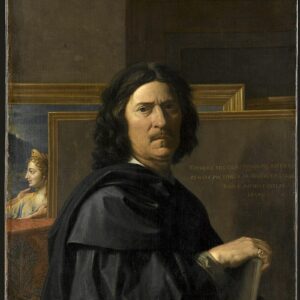Nicolas Poussin was a well-known French painter and draftsman who rose to prominence in seventeenth-century Roman and European art. Except for a brief stint as First Painter to the King in France, he spent his whole working life in Rome. Poussin was a major figure in the development of the classical French Baroque style. His distinction stems from the fact that he added an intellectual dimension to classical art. His area of expertise was historical painting. Scenes from the Bible, mythology, and historical events were depicted in his works. They’re known for their dramatic impulse and narrative clarity. His early paintings were vivid and sensualistic, and they followed the Venetian tradition. The poetry of Ovid and Tasso had a significant influence. His later works, which were more muted and disciplined, owed a debt to Raphael’s classicism. In lieu of color, his sculptures display a ‘nobility of design.’ His paintings cover a wide spectrum of subjects, from bacchic revelry to mourning and moral civic qualities. Poussin spent the latter years of his life painting landscapes and deep allegorical paintings on the harmony of nature. He influenced neoclassical painters such as Jacques-Louis David, Jean-Auguste-Dominique Ingres, and Paul Cézanne in the twentieth century.
Childhood and Adolescence
Nicolas Poussin was born on June 15, 1594, in the Normandy town of Les Andelys. Jean Poussin, his father, was a nobleman who served in the Tavanes division during the reigns of Kings Charles IX, Henry III, and Henry IV. He was educated in Latin, literature, and sciences, but he had a strong preference for painting. Quentin Varin, a local painter, became Poussin’s first tutor after seeing his early sketches.
He moved to Paris in 1612 to study anatomy, architecture, and perspective. He also began taking lessons from minor masters Geroges Lallemand and Ferdinand Elle in Paris. He was introduced to the artistic works of the Italian Renaissance during this time. He was so taken aback that he attempted to visit Rome again, in 1619 and 1622.
When Poussin met Giambattista Marino, Mario de Medici’s court poet, in Lyon in 1622, his fortunes transformed.
Marion accompanied him on an artistic journey to Rome in March 1624.
Marcello Sacchietti, a wealthy patron, had been introduced to Poussin via Marion’s career. He also crossed paths with Cardinal Francesco Barberini and his secretary Cassiano del Pozzo in the mid-1620s. All of these people became Poussin’s patrons. Using Barberini’s contract, he created his first masterwork, ‘The Death of Germanicus,’ in 1628.
Pozzo assisted him in obtaining a commission for an altarpiece for St. Peter’s called “The Martyrdom of St. Erasmus” (1629).
He developed his own style in the late 1620s and 1630s, based on his studies of Titian’s ‘Bacchanals’ and Domenichino and Guido Reni’s paintings. Poussin became a member of the Guild of St. Luke in Rome in 1632.
In 1635–36, Cardinal Richelieu, Louis XIII’s first minister, commissioned him to create a series of bacchanals to embellish the cardinal’s estate. He designed the ‘Seven Sacraments’ for Philip IV, King of Spain, in the late 1630s.
For his greatest patron, Paul Fréart de Chantelou, he painted one of his masterpieces, ‘The Israelites Gathering the Manna,’ in 1638. Upon his arrival in Paris in December 1640, he was appointed First Painter to the King. Some of his greatest figure paintings, such as ‘Eliezer and Rebecca,’ ‘The Holy Family on the Steps,’ and ‘The Judgment of Solomon,’ were painted in the final years of 1640.
Poussin returned to Rome in 1642 and completed the second series of ‘The Seven Sacraments’ six years later.
He painted the ‘Vision of St Paul’ for Paul Scarron, a comedic poet, in 1649, and the ‘Holy Family’ for the duc de Créquy in 1651. He also painted two self-portraits in which he was costumed as an antique in 1649–50.
Major Projects of Nicolas Poussin
The most famous history painting of Poussin’s career is ‘The Israelites Gathering the Manna’ (1638), which gained him the moniker of ‘painter-philosopher.’ Because every brushstroke came together to generate drama, he intended the audience to’read’ the painting.
Another wonderful artwork depicting the early Christian church’s ceremonies is ‘The Seven Sacraments.’ ‘The Song of Solomon’ and ‘The Holy Family on the Steps’ are two more outstanding works that have a splendor and finality that make them some of the best pieces of classical art.
Personal History and Legacy
In 1630, Nicolas Poussin married Anna Maria, the daughter of his fellow countryman Jacques Dughet. The couple didn’t have any children. Poussin’s son-in-law Gaspard Dughet, who later assumed the name Poussin, was adopted by Poussin.
After 1650, he was in poor health. His most recent works highlight the artist’s obsession with death. The loss of his wife in 1665 had a profound impact on him. He died in Rome on November 19, 1665, and was buried at the San Lorenzo church in Luciana.
Estimated Net Worth
The estimated net worth of Nicolas Poussin is not available.


